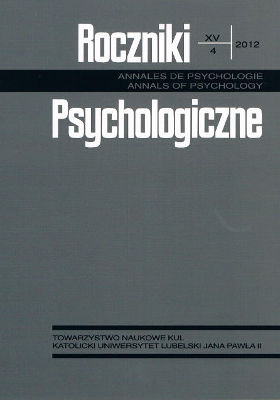Kiedy ostrzeżenie pomaga, a kiedy szkodzi? Wpływ ostrzeżenia na trafność zeznania świadka
Abstrakt
Zaprezentowane w artykule badania dotyczą efektu dezinformacji w kontekście zeznań świadków. Podstawowym celem badań była próba zaprezentowania możliwych konsekwencji (pozytywnych, jak i negatywnych) działania ostrzeżenia o rozbieżnościach między materiałem oryginalnym a materiałem następczym na jakość raportu pamięciowego. Następnym celem było włączenie do typowej procedury badania efektu dezinformacji dodatkowego etapu, jakim była prezentacja kolejnego materiału następczego. W obu badaniach uczestnicy, po zaprezentowaniu im materiału oryginalnego, byli wystawieni na odbiór dwu materiałów następczych – jeden z nich poprawnie powtarzał informacje zawarte w materiale oryginalnym lub zawierał informacje neutralne, w treści drugiego natomiast manipulowano podaniem dezinformacji. Eksperymenty różniły się sekwencją postępowania eksperymentalnego. W eksperymencie I najpierw zastosowano jako pierwszy materiał materiał następczy (nie)dezinformujący, w eksperymencie II powtórzono materiał oryginalny/materiał neutralny. W obu badaniach potwierdzono wszystkie postawione hipotezy. Stwierdzono wystąpienie efektu dezinformacji. Zgodnie z oczekiwaniami, w I eksperymencie w następstwie podania ostrzeżenia odnotowano efekt skażonej prawdy, natomiast w II – całkowitą eliminację efektu dezinformacji.
Bibliografia
Apsler, R., Sears, D. O. (1968). Warning, personal involvement, and attitude change. Journal of Personality and Social Psychology, 9, 162-166.
Bekerian, D. A., Bowers, J. N. (1983). Eyewitness testimony: Were we misled? Journal of Experimental Psychology: Learning, Memory, and Cognition, 1, 139-145.
Blank, H. (1998). Memory states and memory tasks: An integrative framework for eyewitness memory and suggestibility. Memory, 6, 481-529.
Campbell, J. M., Edwards, M. S., Horswill, M. S., Helman, S. (2007). Effects of contextual cues in recall and recognition memory: The misinformation effect reconsidered. British Journal of Psychology, 98, 485-498.
Chambers, K. L., Zaragoza, M. S. (2001). Intended and unintended effects of explicit warnings on eyewitness suggestibility: Evidence from source identification tests. Memory & Cognition, 29, 1120-1129.
Chandler, C. C. (1991). How memory for an event is influenced by related events: Interference in modified recognition tests. Journal of Experimental Psychology: Learning, Memory, and Cognition, 17, 115-125.
Christiaansen, R. E., Ochalek, K. (1983). Editing misleading information from memory: Evidence for the coexistence of original and postevent information. Memory & Cognition, 11, 467-475.
Cohen, H. (1988). Statistical power analysis for the behavioral sciences. Hiilsdale–New Jersey: Lawrence Erlbaum Associates.
Echterhoff, G., Groll, S., Hirst, W. (2007). Tainted truth: Overcorrection for misinformation influence on eyewitness memory. Social Cognition, 25, 367-409.
Echterhoff, G., Hirst, W., Hussy, W. (2005). How eyewitness resist misinformation: Social postwarnings and the monitoring of memory characteristics. Memory & Cognition, 33, 770-782.
Farrar, M. J., Goodman, G. S. (1992). Developmental changes in event memory. Child Development, 63, 173-187.
Greene, E., Flynn, M. B., Loftus, E. F. (1982). Inducing resistance to misleading information. Journal of Learning and Verbal Behavior, 21, 207-219.
Lindsay, D. S., Johnson, M. K. (1989). The eyewitness suggestibility effect and memory for source. Memory & Cognition, 17, 349-358.
Loftus, E. F. (1975). Leading questions and the eyewitness report. Cognitive Psychology, 7, 560-572.
Loftus, E. F. (1979). Reactions to blatantly contradictory information. Memory & Cognition, 5, 368-374.
Loftus, E. F. (2005). Planting misinformation in the human mind: 30-year investigation of the malleability of memory. Learning & Memory, 12, 361-366.
Loftus, E. F., Miller, D. G., Burns, H. J. (1978). Semantic integration of verbal information into a visual memory. Journal of Experimental Psychology: Human Learning and Memory, 4, 19-31.
McCabe, D. P., Smith, A. D. (2002). The effect of warnings on false memories in young and older adults. Memory & Cognition, 30, 1065-1077.
McCloskey, M., Zaragoza, M. (1985). Misleading postevent information and memory for events: Arguments and evidence against memory impairement hypotheses. Journal of Experimental Psychology: General, 114, 1-16.
Metcalfe, J. (1990). Composite holographic associative recall model (CHARM) and blended memories in eyewitness testimony. Journal of Experimental Psychology: General, 119, 145-160.
Neuschatz, J. S., Payne, D. G., Lampinen, J. M., Toglia, M. P. (2001). Assessing the effectiveness of warnings and the phenomenological characteristics of false memories. Memory, 9, 53-71.
Petty, R. E., Cacioppo, J. T., Goldman, R. (1981). Personal involvement as a determinant of argument-based persuasion. Journal of Personality and Social Psychology, 41, 847-855.
Pezdek, K. (1977). Cross-modality semantic integration of sentence and picture memory. Journal of Experimental Psychology: Human Learning and Memory, 3, 515-524.
Pezdek, K., Roe, Ch. (1995). The effect of memory trace strength on suggestibility. Journal of Experimental Child Psychology, 60, 116-128.
Polczyk, R. (2007). Mechanizmy efektu dezinformacji w kontekście zeznań świadka naocznego. Kraków: Wydawnictwo Uniwersytetu Jagiellońskiego.
Reyna, V. F., Brainerd, C. J. (1995). Fuzzy-trace theory: An interim synthesis. Learning and Individual Differences, 7, 1-75.
Szpitalak, M. (2012). Rola motywów autoregulacyjnych w mechanizmach zniekształceń pamięciowych uwarunkowanych efektem dezinformacji (mps pracy doktorskiej, Uniwersytet Jagielloński).
Szpitalak, M., Polczyk, R. (2010). Warning against warnings: Alerted subjects may perform worse. Misinformation, involvement and warning as determinants of eyewitness testimony. Polish Psychological Bulletin, 41, 105-112.
Szpitalak, M., Polczyk, R. (2011a). Zniekształcenia zeznań świadka naocznego – mechanizmy pamięciowe i niepamięciowe. Z Zagadnień Nauk Sądowych, 85, 40-49.
Szpitalak, M., Polczyk, R. (2011b). Czy ostrzeżenie może szkodzić? Wpływ ostrzeżenia na jakość zaznania świadka. Z Zagadnień Nauk Sądowych, 86, 140-150.
Tousignant, J. P., Hall, D., Loftus, E. F. (1986). Discrepancy detection and vulnerability to misleading postevent information. Memory and Cognition, 14, 329-338.
Watson, J. M., McDermott, K. B., Balota, D. A. (2004). Attempting to avoid false memories in the Deese/Roediger-McDermott paradigm: Assessing the combined influence of practice and warnings in young and old adults. Memory & Cognition, 32, 135-141.
Westerberg, C. E., Marsolek, C. J. (2006). Do instructional warnings reduce false recognition? Applied Cognitive Psychology, 20, 97-114.
Wright, D. B. (1993). Misinformation and warnings in eyewitness testimony: A new testing procedure to differentiate explanations. Memory, 1, 153-166.
Wright, D. B., Loftus, E. (1998). How misinformation alters Memories. Journal of Experimental Child Psychology, 71, 155-164.
Zaragoza, M. S., Lane, S. M. (1994). Source misattributions and the suggestibility of eyewitness memory. Journal of Experimental Psychology: Learning, Memory, and Cognition, 20, 934-945.
Copyright (c) 2012 Roczniki Psychologiczne

Utwór dostępny jest na licencji Creative Commons Uznanie autorstwa – Użycie niekomercyjne – Bez utworów zależnych 4.0 Międzynarodowe.


